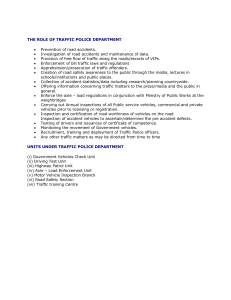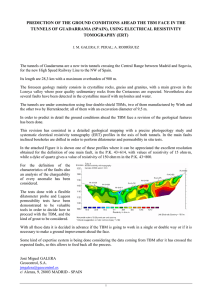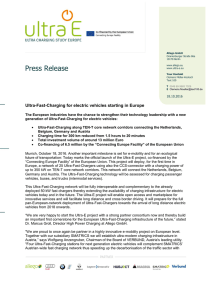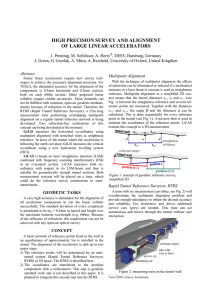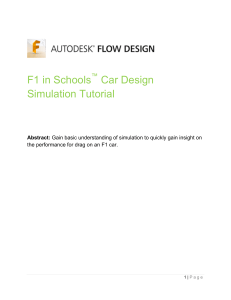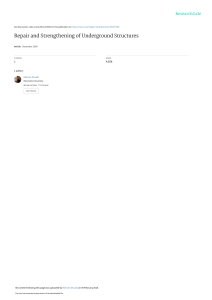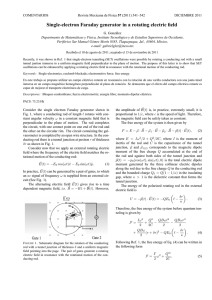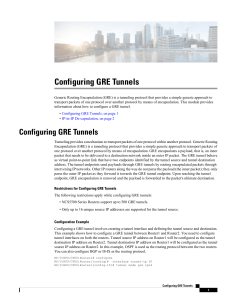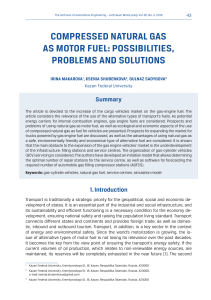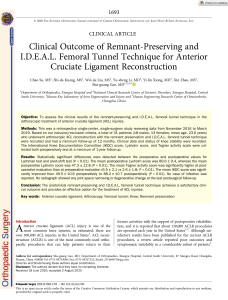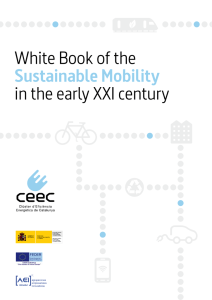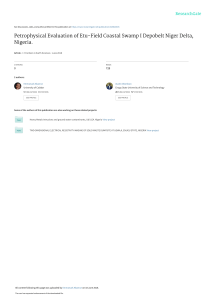iv. capacity and speed in relation to the
Anuncio
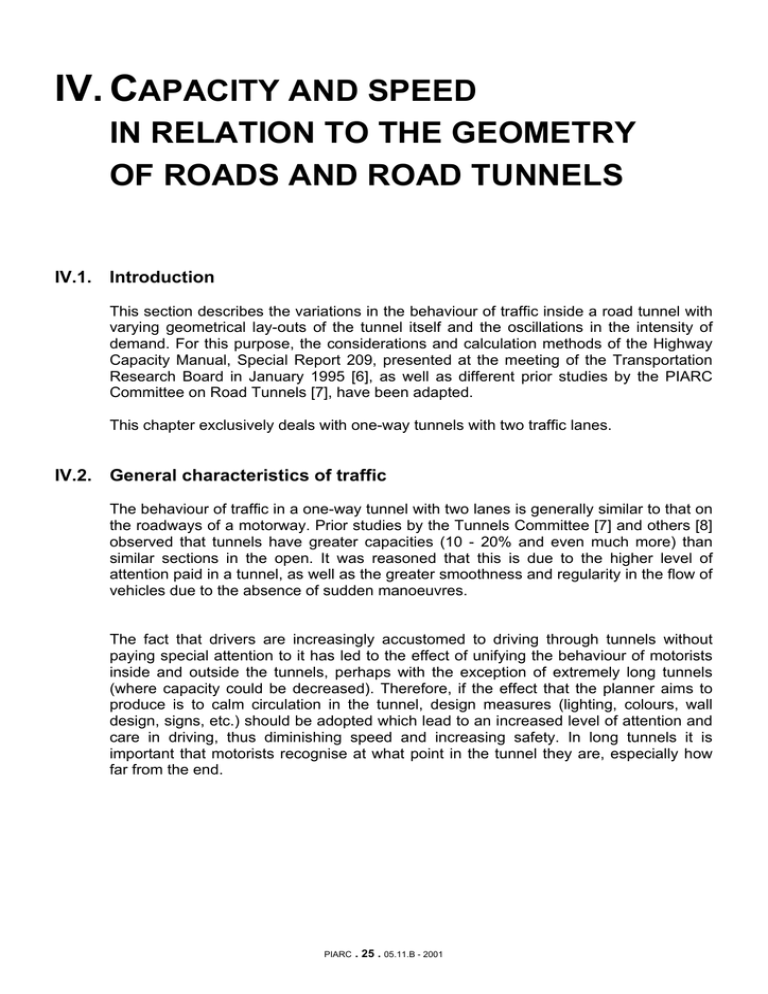
IV. CAPACITY AND SPEED IN RELATION TO THE GEOMETRY OF ROADS AND ROAD TUNNELS IV.1. Introduction This section describes the variations in the behaviour of traffic inside a road tunnel with varying geometrical lay-outs of the tunnel itself and the oscillations in the intensity of demand. For this purpose, the considerations and calculation methods of the Highway Capacity Manual, Special Report 209, presented at the meeting of the Transportation Research Board in January 1995 [6], as well as different prior studies by the PIARC Committee on Road Tunnels [7], have been adapted. This chapter exclusively deals with one-way tunnels with two traffic lanes. IV.2. General characteristics of traffic The behaviour of traffic in a one-way tunnel with two lanes is generally similar to that on the roadways of a motorway. Prior studies by the Tunnels Committee [7] and others [8] observed that tunnels have greater capacities (10 - 20% and even much more) than similar sections in the open. It was reasoned that this is due to the higher level of attention paid in a tunnel, as well as the greater smoothness and regularity in the flow of vehicles due to the absence of sudden manoeuvres. The fact that drivers are increasingly accustomed to driving through tunnels without paying special attention to it has led to the effect of unifying the behaviour of motorists inside and outside the tunnels, perhaps with the exception of extremely long tunnels (where capacity could be decreased). Therefore, if the effect that the planner aims to produce is to calm circulation in the tunnel, design measures (lighting, colours, wall design, signs, etc.) should be adopted which lead to an increased level of attention and care in driving, thus diminishing speed and increasing safety. In long tunnels it is important that motorists recognise at what point in the tunnel they are, especially how far from the end. PIARC . 25 . 05.11.B - 2001 IV.3. Theoretical capacity and practical capacity The Theoretical Capacity of a road section is defined as the maximum intensity per hour of vehicles. It is determined by measuring the maximum number of passenger cars in a fifteen-minute period and multiplying this by a peak hour factor. This is not an absolute maximum, but rather refers to reasonable repeatability. Expressed in this way, the capacity only depends on the number and width of lanes and off-carriageways and the slope of the section. It does not depend on the percentage of heavy vehicles, since it is clear that this intensity will be maximum when traffic is formed exclusively by light vehicles and regular drivers. If there are no elements that limit it, this theoretical capacity is approximately 2,200 vehicles per hour per lane (v/hxl). If one would like the capacity to refer to the number of vehicles, taking into account the percentage of heavy vehicles, the Practical Capacity is expressed. This is defined as the maximum intensity per hour of vehicles that can cross this section in a fifteen-minute period, with the composition of traffic that prevails in that location. The practical capacity of a section is calculated based on the theoretical capacity without the previously mentioned restrictions (2,200 v/h/l). Limiting factors are applied based on the actual characteristics of the roadway. These factors are as follows: • Fw which reduces the capacity depending on the width of the lanes and the offcarriageways. It is considered that a lane does not limit the practical capacity if the width is equal to or greater than 3.60 m. An off-carriageway does not limit the practical capacity if the width is equal to or greater than 1.80 m. Widths greater than those indicated do not offer increased capacity nor driving comfort, although they can lead to greater traffic speed. In restrictive conditions, the factors should be interpolated based on (table 4-1). The actual effect of an obstacle on traffic should be studied carefully. Regardless of whether they are continuous or discontinuous, obstacles produce a similar effect. For example, the periodic supports of an element. Nevertheless, regular users may become accustomed to certain obstacles, so that they do not reduce the capacity. A typical case of an obstacle which does not limit the capacity for regular users is the rigid “New Jersey” type concrete barrier. When there are obstacles on both sides, but at different distances, the distances on each of the sides can be averaged. • Fhv Heavy vehicle factor, which adjusts the theoretical capacity depending on the percentage of heavy vehicles and the inclination and length of the ramp or slope of the roadway. Values for this factor can be determined using table 4-2. • Fc Correction factor due to the predominant type of driver. This factor adjusts the capacity based on whether the drivers are regular drivers along the route and if the type of traffic is that of a working day. If both of these components are true, this provides the maximum capacity. If the drivers are not regular drivers or the traffic is recreational or weekend traffic, then the factor may decrease to a minimum of 75%. PIARC . 27 . 05.11.B - 2001 Table 4-1: Adjustment Factor Fw Distance from roadway to obstacle (in meters ) Adjustment Factor Fw Obstacles on one side Obstacles on both sides Width of lane ( in metres ) 3.30 3.00 3.30 3.00 ≥3.60 ≥3.60 1.00 0.95 0.90 1.00 0.95 0.90 0.99 0.94 0.89 0.98 0.93 0.88 0.97 0.92 0.88 0.95 0.90 0.86 0.92 0.88 0.84 0.86 0.82 0.78 ≥1.80 1.20 0.60 0.00 Table 4-2: Heavy Vehicle Factor Fhv Inclination (%) <2 2 3 4 5 Length of ramp (m) All 0-400 400-800 800-1200 1200-1600 1600-2400 > 2400 0-400 400-800 800-1200 1200-1600 1600-2400 > 2400 0-400 400-800 800-1200 1200-1600 > 1600 0-400 400-800 800-1200 1200-1600 1600-2400 > 2400 Eq Equivalence factor in ramps Percentage of heavy vehicles ( % ) 4 6 8 10 1,5 1,5 1,5 1,5 1,5 1,5 1,5 1,5 1,5 1,5 1,5 1,5 1,5 1,5 1,5 1,5 2 2 1,5 1,5 3 3 2,5 2,5 3,5 3 2,5 2,5 1,5 1,5 1,5 1,5 2,5 2 2 2 4 3,5 3,5 3 5,5 4,5 4 4 6 5 4,5 4 6 5 4,5 4,5 1,5 1,5 1,5 1,5 4 3,5 3 3 7 6 5,5 5 8 6,5 6 5,5 8 7 6 6 2 1,5 1,5 1,5 4,5 4 3,5 3 7 6 5,5 5 9 8 7 7 9,5 8 7,5 7 9,5 8 7,5 7 15 1,5 1,5 1,5 1,5 1,5 2 2 1,5 2 2,5 3,5 4 4 1,5 3 4,5 4 5 1,5 3 4,5 6 6,5 6,5 20 1,5 1,5 1,5 1,5 1,5 2 2 1,5 1,5 2 3 3 3 1,5 2,5 4 4,5 5 1,5 2,5 4 6 6 6 In table 4-2, the Equivalence Factor Eq needs to be used. It is determined as the relation between the demand of capacity for heavy vehicles (lorries, buses, trailers) and the demand of capacity for a personal car. The Equivalence Factor Eq varies between 1.5 and 10 or more for lorries and buses, depending on the length and gradient of the slope and between1.2 and 5 for recreational vehicles. Once the Eq factor has been determined, the Fhv is calculated by: Fhv = ( 1 + Pc ( Eq – 1 ) ) –1 In which: Pc is the proportion of heavy vehicles in the total Intensity. PIARC . 29 . 05.11.B - 2001 IV.4. Calculation of practical capacity The practical capacity of a carriageway in one direction, Cp , is calculated then by: Cp= 2200 x N x Fw x Fhv x Fc In which N is the number of lanes and the different factors are those indicated previously (N=2 for the tunnels considered in this report). IV.5. Saturation level and traffic speed The Saturation Level of the traffic is determined by dividing the Intensity by the Practical Capacity ( SL = I / Cp ), At low saturation levels the average speed in a tunnel, just as on a road in the open, will depend on the geometric characteristics of the tunnel. The wider the curves and the gentler the slopes, the greater the speed. This speed at low congestion is called the free flow speed. Other parameters that define the free flow speed are travel purpose, travel length and speed limits, especially if such limits are enforced with frequent supervision and high fines. Japanese experiments [9] indicate that measures to improve visual guidance (kind and colour of the cladding or illuminating line markings) can increase average speed and capacity as well. For a certain road section or tunnel this free flow speed can only be determined by measuring speed in practice. The free flow speed, however, can be estimated as approximately 90% of the design speed. For higher saturation levels the behaviour of traffic speed is as shown in table 4-3. As can be observed, when the road is saturated (SL = 1), traffic speed is approximately 86 to 91% of the free speed. The lower the saturation, the more closely the traffic speed equals the free speed. At high saturation levels traffic conditions will be congested with consequent low speed and low total traffic flow. Queues inside a tunnel should be avoided normally so as to limit the total number of people affected by an emergency situation. In continuous flow condition, the maximum traffic density (expressed in vehicles per km and per lane v/km/l) is 30, corresponding to a separation of 33 m, while in congestion the density increases to 130 v/km/l, corresponding to a separation of about 7.5 m. PIARC . 31 . 05.11.B - 2001 Table 4-3: Traffic speed (km/h) as function of saturation level Saturation Level (SL) Free Flow Speed 115 105 0 to 0.4 115 105 0.5 115 105 0.6 114.9 105 0.7 114.3 104.3 0.8 110.1 102.1 0.9 104.5 97.8 1.0 (Capacity) 98.5 90.4 Speed in capacity / Free Speed 0.86 0.86 95 95 95 95 93.9 91.2 87.8 84.0 0.88 85 85 85 85 84.9 84.7 81.9 77.3 0.91 There is little information about the variation of speed between the driving and overtaking lanes in tunnels. At low traffic intensities, the difference can be as much as 20%, or as little as 4% at high traffic intensities such as near 2200 v/h/l. IV.6. Concluding remarks The tables and figures dealt with in this chapter are those of the Highway Capacity Manual in vigour in the last decades. In national regulations other tables and figures are possible due to different traffic regulations, behaviour, etc. PIARC . 33 . 05.11.B - 2001
